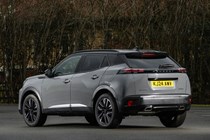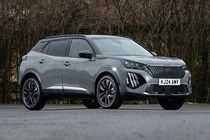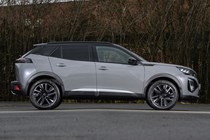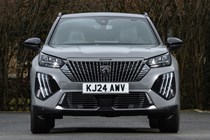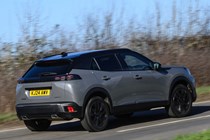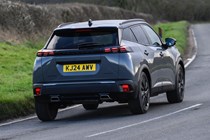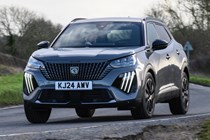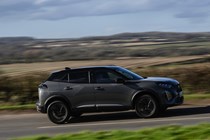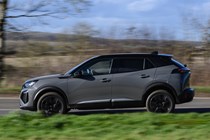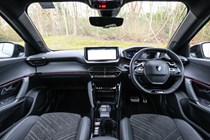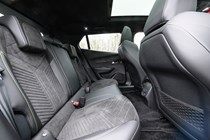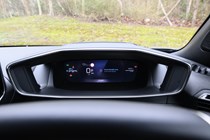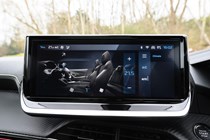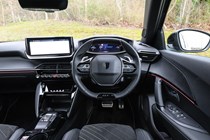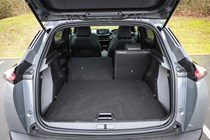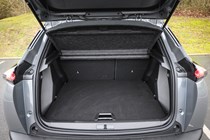
Peugeot 2008 long-term test
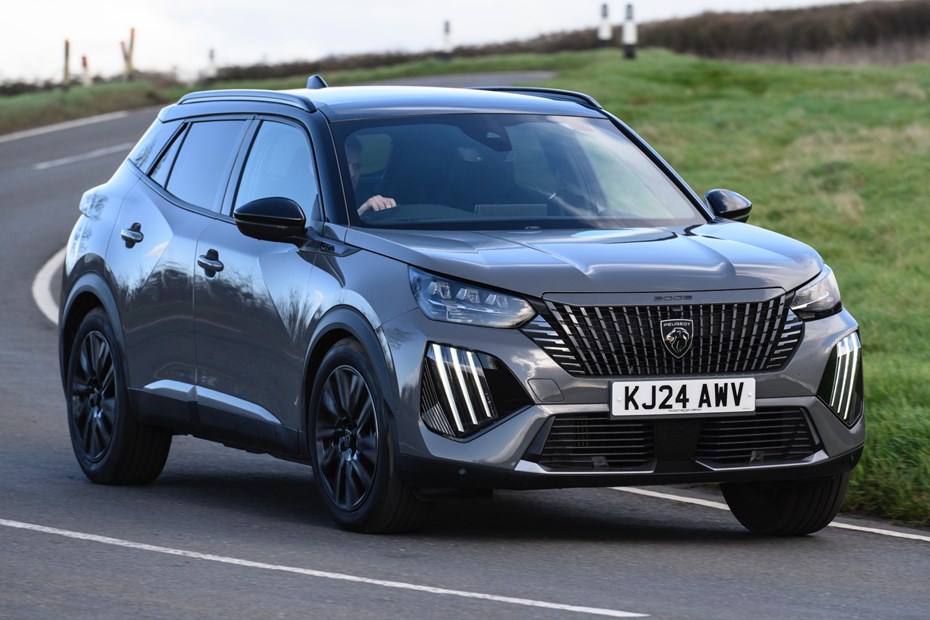
We’re running a Peugeot 2008 for six months to see what it’s like to live with over an extended period. The full report follows, or you can click straight through to the section you’re interested in below.
Report 1: We get to know our new long-term Peugeot 2008 – a 155hp GT Premium model resplendent in ‘Orange Fusion’
Report 2: Peugeot’s pushing for premium – does our long-term 2008 SUV deliver the goods?
Report 3: After nearly 5,000 miles behind the wheel we’ve really got to know the 2008’s foibles – here’s our favourite pros and most pedantic cons
Report 4: Our Peugeot 2008 impresses on a long drive through its home country
Report 5: Petrol or electric power? We compare our Peugeot 2008 to its e-2008 sibling
Report 6: We wave goodbye to our Peugeot 2008 after six months – is it still a great compact SUV?
Report 1: Welcome and introduction
We get to know our new long-term Peugeot 2008 – a 155hp GT Premium model resplendent in ‘Orange Fusion’
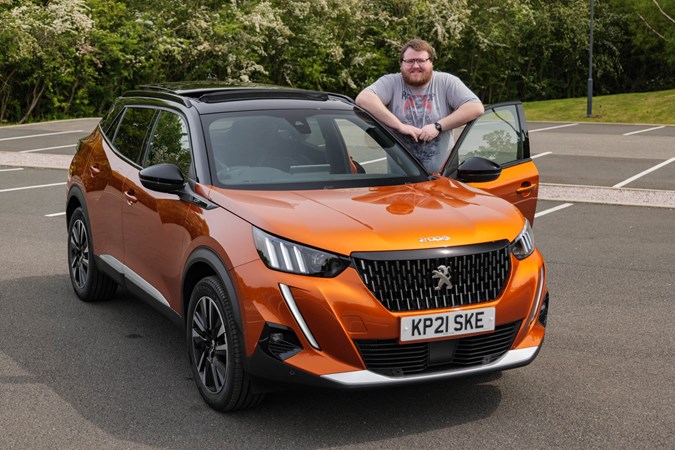
With the number of different compact SUVs on the market currently sitting at around a million (or so it feels) it can be really hard for models to stand out from one another. That’s especially tough when so many share engines, technology and even whole platforms with each other.
As a case in point, the Peugeot 2008 I’ve got here and will be running for the next six months is mechanically nearly identical to the Vauxhall Mokka, the Citroen C4 and DS 3 Crossback. The models are priced in a clear hierarchy, with the Peugeot being the second-priciest after the DS.
I’ve got this time with the car then to figure out not just if it’s worth the extra over its sister cars, but whether it’s a good car in its own right – and worthy of consideration over rivals like the Volkswagen T-Cross, Mazda CX-30 or Parkers Award-winning Ford Puma.
Parkers Car of the Year 2021 – Ford Puma
Which Peugeot 2008 have we got here?
This is, for all intents and purposes, the range-topping model. It’s a 155hp petrol model, fitted with an eight-speed automatic gearbox and in top-drawer GT Premium trim.
Though the all-electric e-2008 is pricier, it’s this petrol that provides the greatest performance. 0-62mph takes a genuinely rapid 7.9 seconds and top speed is 129mph. That’s none too shabby for a sensible family crossover.
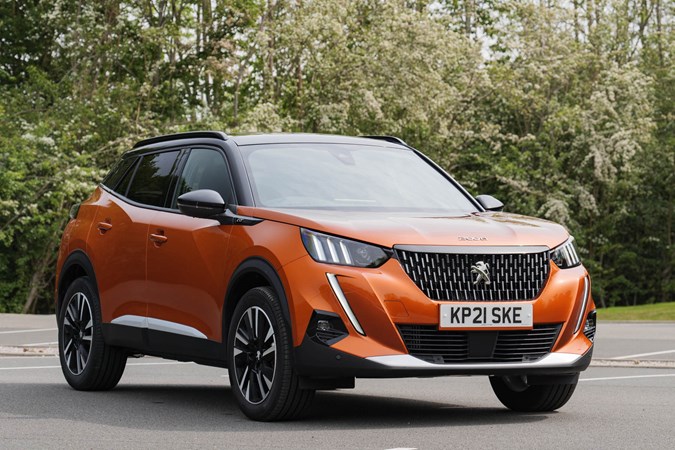
As for the trim level, you’d hope for a generous amount of equipment from the range-topper and the 2008 doesn’t disappoint. On the outside, 18-inch alloy wheels join a contrasting roof and full LED lights, while the inside is loaded with kit, including:
- 10-inch infotainment touchscreen, including 3 years of Peugeot’s ‘Connected’ TomTom navigation
- 3D i-Cockpit digital dashboard
- Keyless entry and start
- Adaptive cruise control with stop & go
- Lane-departure warning and lane-keep assist
- Wireless smartphone charging
- Apple CarPlay and Android Auto
- LED mood lighting
- Heated front seats
- All-round parking sensors and reversing camera
- Autonomous emergency braking
- Blind-spot monitoring
Just about the only strange omission from this list is multi-zone climate control. That’s not something I’m personally bothered by, as I’m usually the only person in the car, but dual-zone climate is so common even on lower-specification cars it not being present here seems strange.
We’ve also added one option from the short options list – an opening panoramic sunroof, which brightens up the 2008’s fairly dark interior and lets in a nice breeze on warm days.
The price for all this luxury, though? Over £30,000 – or around £384 per month on Peugeot’s own PCP scheme, albeit with a low £1,633 deposit.
One handsome cat
The first distinction the Peugeot has over its sister cars is the way it looks. The Peugeot family face with its ‘sabre-tooth’ LED lights works particularly well here, and I think it’s all set off brilliantly by my car’s ‘Orange Fusion’ paint – the only no-cost option for GT Premium cars.
Another divergence is the interior, which works rather differently to its siblings. It’s typical Peugeot, with most functions controlled by the 10-inch infotainment display – there’s a row of hot keys underneath it to provide shortcuts to essential functions such as navigation or climate, but all of the adjustments are made on the screen itself.
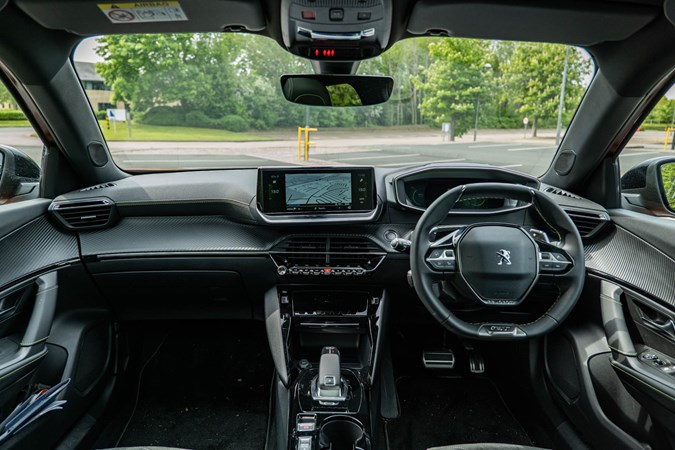
The overall effect is of a cabin that’s very sleek and attractive. It’s set off with imitation carbon fibre on the dashboard, while GT Premium cars come with acid-green stitching on the dash and seats – not the obvious choice to match with an orange exterior, but one I quite like.
It’s not always the easiest interior to use, but I’ll be getting on to that in a future update.
First impressions
I’m a die-hard Peugeot fan – I own two older models and like everything in the brand’s current lineup – so it’s no surprise I think the 2008 is an excellent small SUV. The coming months will be about challenging whether it’s objectively as good as its rivals – in terms of its practicality, how it drives, and how cheap it is to run.
But buying a car isn’t purely driven by numbers, so I’ll also be seeing if that emotional connection can handle six months of daily driving. It’ll be interesting to find out.
Mileage: 4,250 miles
This month’s economy: 43.1mpg
Official fuel economy: 41.7mpg-46.6mpg
Report 2
Peugeot’s pushing for premium – does our long-term 2008 SUV deliver the goods?
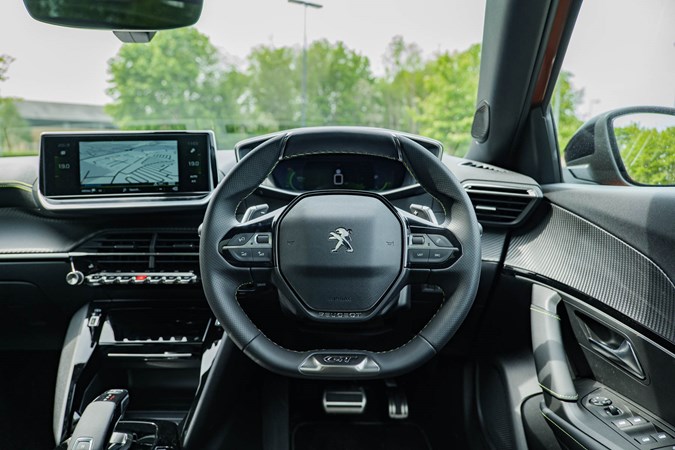
A few months in with our Peugeot 2008 isn’t exactly throwing up any surprises. And in a way, that’s a good thing – the last thing you want in a sensible family car is a nasty discovery when it’s too late to change your mind.
Instead, it’s proving every inch the practical and sensible daily driver, but with a premium veneer that makes life with this SUV much more pleasant than with some of its rivals.
Of course, nobody’s going to mistake a Peugeot for an Audi or a BMW any time soon. But the lion’s push towards the premium is steadily making it feel more like a rival for VW – a sort of semi-posh Marks and Spencer-style brand. Nowhere is this more apparent than on the inside.
Posh interior is a great place to be
Despite a modest mid-table finish in our recent test of small SUVs, the Peugeot’s interior was its standout feature – with quality rivalling the upmarket Audi Q2.
In fact, ever since the 3008 SUV launched back in 2016 Peugeot’s interiors have been really impressive. The 2008’s feels high quality, with nice squishy plastics in all the areas you’re likely to touch. Chunky chrome highlights the main controls and the seats are a comfortable combination of leather and Alcantara.
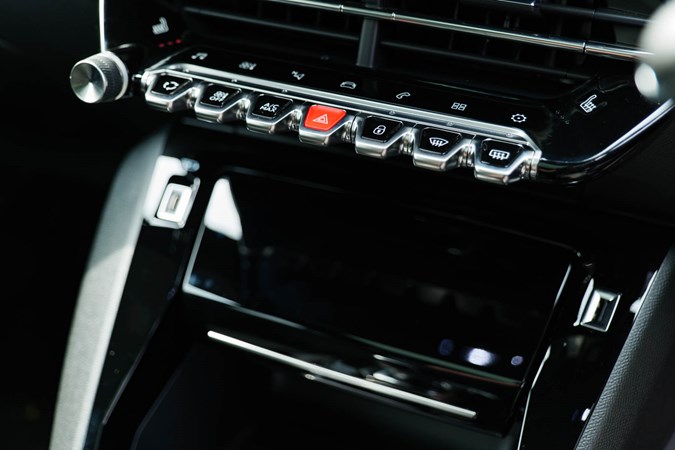
For the thousands of miles I’ve already spent behind the wheel, it’s proved a really comfortable and pleasant place to sit.
Second opinion…
Parkers own finance editor Murray Scullion found himself in need of the 2008’s considerable talents for a recent holiday, given that the all-electric Citroen e-C4 he was running at the time wouldn’t quite manage the distance without many inconvenient charge stops.
I reckon he just wanted a car to match his hair. Take it away, Murray…
“Over seven days, 740 miles, and an unfathomable amount of rain, the things I initially liked about the 2008 grew and grew while its little annoyances developed into eye-twitching irritations.
We’ll start with the good stuff. It looks brilliant. The car’s ‘Orange Fusion’ paint really suits the bold, sharp lines. It genuinely received two compliments from chatty passers-by.
The all-round practicality is good, too. The boot swallowed suitcases, tripods, and deckchairs with no problems and the storage nooks and crannies up front could hold all the parking tickets, keys, and phones I could throw at them.
The 3-D i-Cockpit manages to be brilliant and annoying. The driver’s 3-D screen looks futuristic and is also really easy to read. However, as a man of 5’8” on a good day, I still need to have the steering wheel too low for my liking to see over it and see this screen.
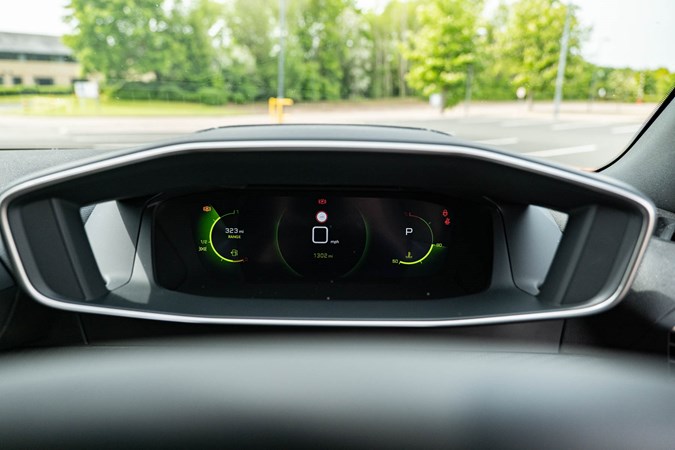
Now for the real irritations. One bugbear was the mpg. I did around 41mpg, which isn’t that bad compared with an official 46.6mpg. But other petrol engines out there with similar power and torque figures will easily crack 50mpg.
The biggest problem I found was the climate controls. You have to navigate your way onto a separate menu on the car’s infotainment. I found it infuriating every single day.”
I can’t find myself agreeing with all of Murray’s complaints. I’ve found that the i-Cockpit dials tend not to be a problem – what feels like an unusual driving position at first soon becomes comfortable, and what may seem unnatural on a short test drive soon becomes less of an issue once you’ve had the car for a few weeks.
The climate controls are also less of a problem than I thought they’d be – they simply don’t need to be adjusted on the fly that often. That doesn’t mean I wouldn’t prefer physical controls, but the touchscreen’s large and reasonably responsive.
The thing that’s annoying me most is the stop-start system. It’s far too enthusiastic to stop, but nowhere near as peppy when it comes to starting back up again. At a roundabout it’s really annoying, and can lead to some real jerkiness – I’ve taken to just turning it off if I know I’m going to be in a lot of traffic, which really defeats the purpose.
Mileage: 4,781 miles
This month’s economy: 44.4mpg
Official fuel economy: 41.7mpg-46.6mpg
Report 3
After 5,000 miles behind the wheel we’ve really got to know the 2008’s foibles – here’s our favourite pros and most pedantic cons
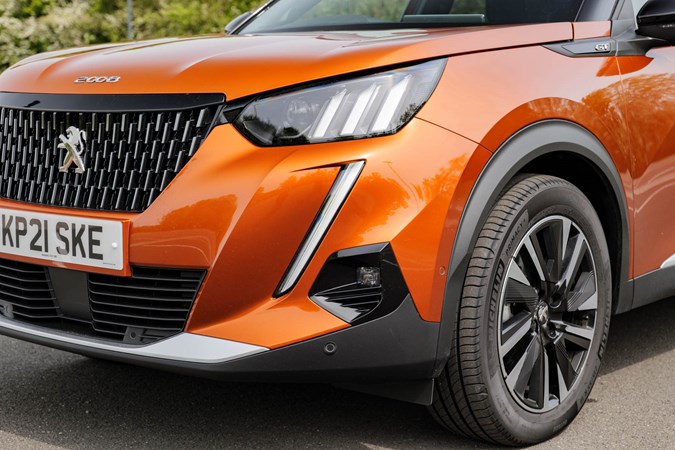
Pro: the 3D dials aren’t just cool to look at, they’re clear and easy to read. Top marks for clarity, though I miss having a mock analogue speedo.
Con: changing the brightness is an absolute pain. It’s buried deep in the confusing menu system and for someone like me with dreadful night vision that’s an exercise in frustration.
Pro: green interior stitching. Looks cool, clashes wonderfully with the orange exterior.
Con: the ambient lighting follows the line of the stitching… which means the only one of its many colour choices I can use is green, otherwise there’s just too much going on. Chaos, I tell you.
Pro: there’s wireless phone charging.
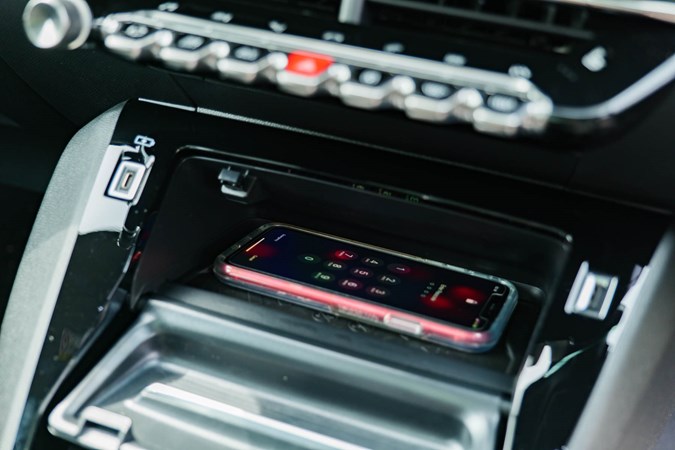
Con: I can’t use the wireless phone charging, because my phone needs to be plugged in in order to use Android Auto.
Extra con: there are two USB ports on the dash, a standard USB-A port and a newfangled USB-C. The latter can only be used for charging, and not for connecting to Apple CarPlay or Android Auto. What a pain.
Pro: the big sunroof not only lets a ton of light in, it actually opens. Much better than a static glass roof.
Con: the rear windows aren’t big and barely open. Not that I often have rear-seat passengers, but it still spoils rear three quarter visibility.
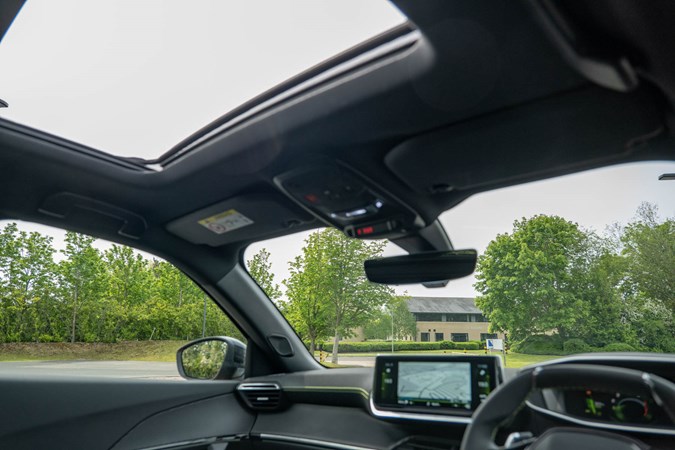
Pro: it’s rapid. Genuinely so. 155hp in a relatively compact package means a 0-62mph sprint of 7.9 seconds. There’s more than enough grunt to really embarrass people at the front of a queue, as they don’t expect a little crossover to take off as quickly as it does.
Extra pro: the little 1.2-litre triple sounds surprisingly sporty.
Con: fuel economy of 40ish-mpg if I’ve not been driving carefully isn’t great.
Pro: I like the small steering wheel, despite what people say.
Con: I don’t like the absolute mess of stalks behind it. Indicator and wiper stalks, I can get behind. But there are also gearshift paddles (attached to the column rather than the steering wheel, so they don’t move while you’re turning) and, inexplicably, the cruise controls. Every single one of these stalks has their functions perfectly blocked by the spokes of the wheel.
Pro: I still enjoy driving it.
Mileage: 4,941 miles
This month’s economy: 45.1mpg
Official fuel economy: 41.7mpg-46.6mpg
Report 4: A trip to France
Our Peugeot 2008 impresses on a long drive through its home country
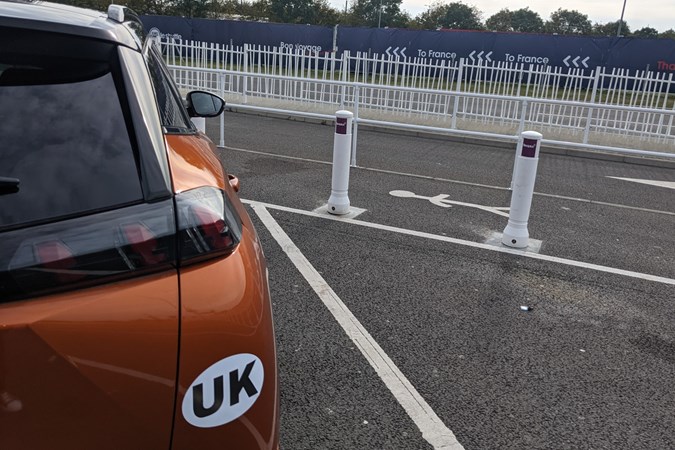
Virus or no virus, the world’s beginning to open up again – and for us here at Parkers, that means the gradual return of the international car launch.
But when the invitation came through to drive the Peugeot e-Partner and Citroen e-Berlingo in Maffliers, a town a little north of Paris, I wondered if a return to the old ways could wait for a little longer yet. You see, we’d usually fly to these events, but I’ve always felt that the hop from Heathrow to Charles de Gaulle is barely worth getting on the aircraft for.
When the journey to Heathrow takes significantly longer than the flight itself, the temptation for me is always to make use of the Eurotunnel and drive instead. And that’s exactly what I ended up doing, with my long-term Peugeot 2008 for company.
An easy route
My journey couldn’t have been easier. My hosts had been kind enough to book me Eurotunnel’s Flexiplus service – this allows you the luxury of turning up at Folkestone whenever you like and simply getting on the next train.
That meant a leisurely, 11am start from Peterborough followed by a painless two hours and forty minutes down to the Eurotunnel terminal via the M11, M25 and M20.
Once on the other side of the channel (and loaded up with macarons, courtesy of the Flexiplus lounge) it was even easier – I got straight onto the A16 and stayed there until I was a mere mile or two from my final destination.
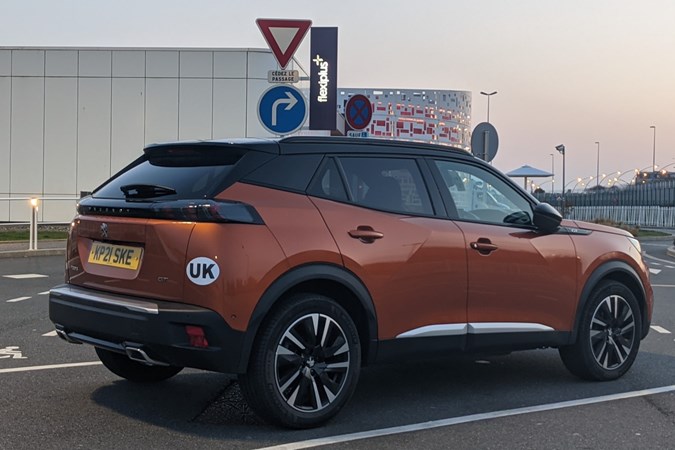
Despite the pandemic, transiting via Eurotunnel was a pretty painless experience, and I encourage anybody who’s perhaps a bit queasy about flying at the moment to consider a driving holiday to Europe instead.
Passport control checked both my real passport and my vaccine passport, had a quick shufty in my boot to make sure I wasn’t smuggling anybody and I was on my way. It couldn’t have been simpler, and you’re able to remain in your own car the entire time, far away from other people. Ideal for introverts.
Better yet, on the other side – no faffing about at a car hire desk, no worrying about public transport. Just make sure you’re on the right side of the road and be on your way.
All you need to know about driving in France
The perfect companion
I’ve already mentioned that the Peugeot 2008 is a comfortable car, and that comes into its own on a long motorway slog. Supportive seats, a soft ride, good refinement and plenty of power for decisive overtakes meant the three hours I spent on the A16 flew by.
Despite the UK plates (not to mention the UK sticker – the Northern-Ireland-including replacement for the old GB sticker) marking me out as a tourist, I felt at home in the Peugeot. And it wasn’t short of attention – both the official at French passport control and an appreciative couple in the queue at Calais gave it very genuine-sounding compliments. Perhaps it’s the orange paintwork, or the smart alloys and two-tone trim of my GT Premium model.
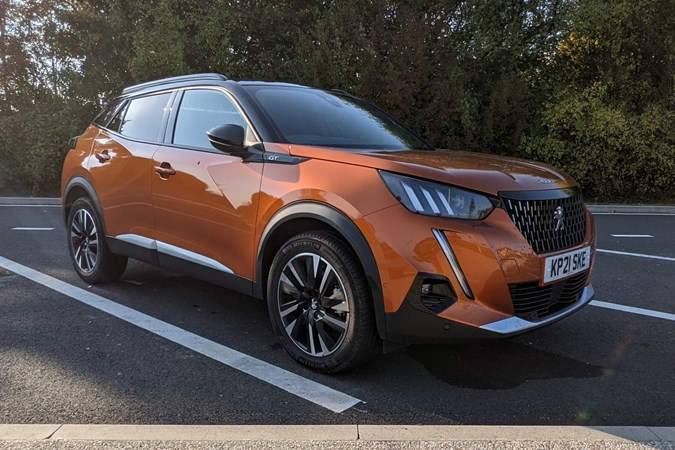
Fuel economy of around 43mpg can be put down to my sticking to the French motorway speed limit of 130km/h (81mph) almost all the way down – I’ve yet to note fantastic economy from my car’s 155hp engine, but if I’d stuck at around 110km/h (68mph) I’ve no doubt it would have improved.
In fact, I can only think of two complaints of the whole trip, making it highly successful by my standards. The first is the indignancy of trying to pay a toll on a French motorway in a right-hand drive car. Shuffling over to the passenger seat and stretching was not a dignified procedure.
The second was the sheer number of bugs that ended their days on my windscreen. I had to stop twice to deploy my emergency Windex and microfibre.
Neither of these were faults with the car though, and I can continue to thoroughly recommend the 2008 for any long journey. And with a boot full of plenty of pink wine, raclette cheese and posh soap, I can continue to recommend driving to and from France instead of flying, too.
Mileage: 5,733 miles
This month’s economy: 42.8mpg
Official fuel economy: 41.7mpg-46.6mpg
Report 5
Petrol or electric power? We compare our Peugeot 2008 to its e-2008 sibling
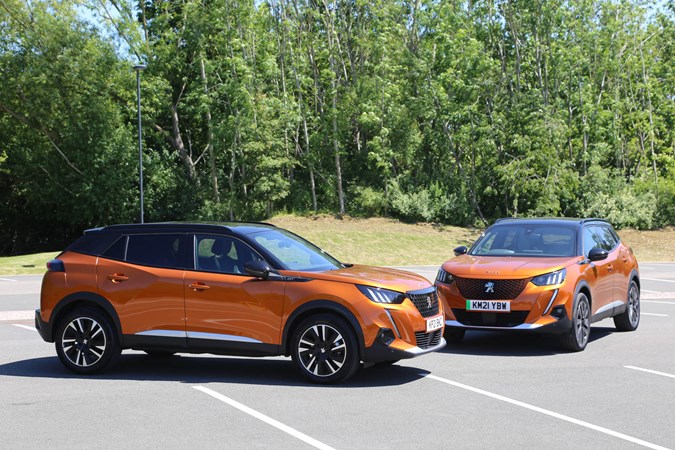
The 2008 is available with several different powertrains, and among them is a fully electric variant – the e-2008.
Keen to see if this battery-powered model was as good as, or better, than my 1.2-litre petrol, I grabbed hold of one – conveniently in almost the same colour and specification – to see how they compared.
To e or not to e
I won’t list off the specifications of both cars – you can read those on their respective specs pages, linked below:
On paper, my petrol 2008 wins in performance – it’s quicker from 0-62mph and has a higher top speed. But the numbers don’t always tell the full story. The fact is, with the instant torque and smooth response of an electric motor, the e-2008 feels nearly as perky, especially around town speeds.
Up to 30mph or so I’m sure it’d beat my petrol 2008 in a race.
Running costs also prove a decisive win for the electric car. If I were to charge the e-2008 at home (the calculations become stickier when using public charging points, but more on that in a minute) on my current energy tariff (approx. 23p per kWh), the ‘fuel’ would cost me 8.4p per mile.
With petrol prices at the levels they are now (around £1.45 per litre), the 2008 would cost me around 15.6p per mile.
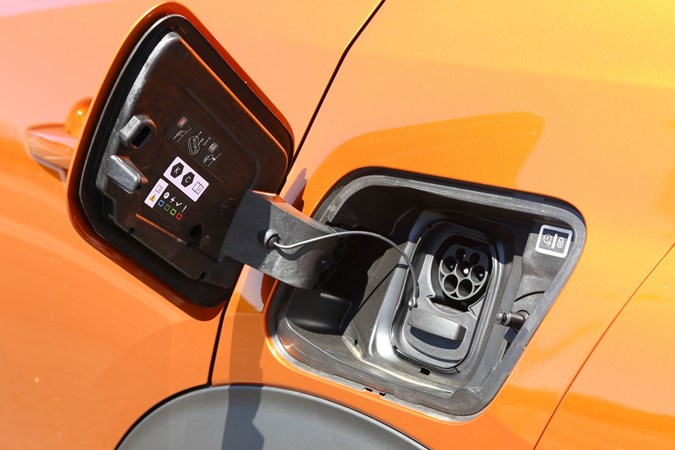
Now, neither of those figures will be accurate 100% of the time – the e-2008 doesn’t always achieve its claimed battery range, for example, and I’m yet to see the advertised average fuel economy from my petrol 2008 either. But it’s a huge difference.
Yet the price difference between the two cars (£7,215 at the time of writing) means it’d still take more than four years before I reached the break-even point. And that’s based on my high annual mileage, around twice as much as the average person drives in a year.
A few other factors could be brought into consideration – the e-2008 doesn’t attract any road tax, while the 2008 does, and maintenance on an electric car does tend to be cheaper with fewer wear parts, no oil or belts to change and less of an appetite for brakes and tyres thanks to regenerative braking. And if I were a Londoner, the daily congestion charge would make it a no-brainer.
Even factoring that in, though, for most people it’d take a lot of miles before the day-to-day cost saving of running an e-2008 eroded the additional purchase price. Over a regular three-year finance package, you’d never hit that break-even point. And if you use public charging, all bets are out of the window. These range from slightly more expensive than home charging to slightly more expensive than filling the tank with diamonds. Visit an Ionity charger without an account, and you’ll be charged 69p per kWh – that’s more than 25p per mile in the e-2008!
But is the rest of the car good enough to warrant the cost? Well, the e-2008 is seriously pleasant to drive, and it’s just as spacious as its combustion siblings. As with so many affordable electric cars, though, where it falls down is when it comes to driving range.
She doesn’t have the range
In the official tests the e-2008 returned a maximum range of 214 miles, which sounds good and is competitive with most rivals. But I’ve never been able to achieve anywhere even close to this in practice – I’ve topped out at around 160 miles, and in cold weather that plummets closer to 130. Staying on the motorway? Budget for 100.
Even that wouldn’t be enough to give me range anxiety, but something else is – the way it’s reported. You see, all Peugeot, Citroen and Vauxhall electric cars use the same software for their ‘range remaining’ gauge, and it reports the ‘best-case’ scenario at the start of every drive. That means as you cover your first few miles, it plummets disconcertingly, leaving you little faith in it.
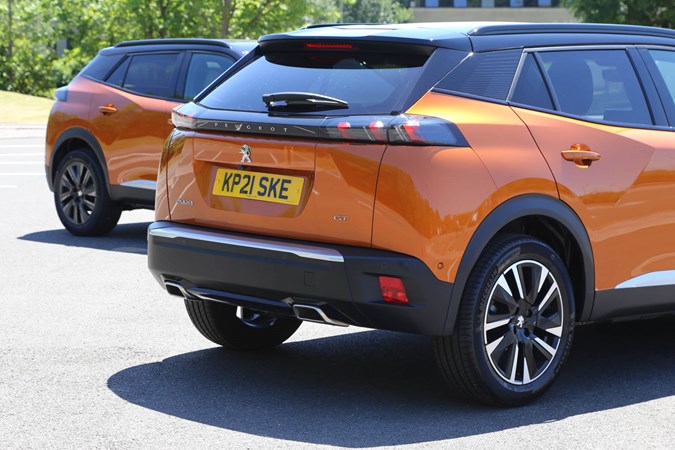
With an accurate range gauge you can plan for charging stops, but the one on the e-2008 and its related cars is just anxiety-inducing, and you’re never quite sure if you can trust it. This would be a deal-breaker for me.
So, what’s it to be?
I can see the appeal of the e-2008, like I can with all electric cars. It’d suit someone with a predictable commute that falls within the car’s range, and who’s able to charge it at home on cheaper electricity.
But that misleading range counter and the limited overall driving range means that for me, I’d stick with the petrol car. Which I’m still enjoying.
Mileage: 5,914 miles
This month’s economy: 42.6mpg
Official fuel economy: 41.7mpg-46.6mpg
Report 6: Farewell and final thoughts
We wave goodbye to our Peugeot 2008 after six months – is it still a great compact SUV?

The best outcome for running a Parkers long-term test car is that, when the manufacturer takes the vehicle back at the end of the loan, you regard it as highly or higher than you did when you first took ownership.
I’m glad to report that’s the case with the Peugeot 2008, which over six months and several thousand miles has stubbornly refused to reveal any real chinks in its armour.
It’s not the best compact SUV on the market, at least not according to our own reviews. And it’s true that the Ford Puma provides a more rounded package, and the Skoda Kamiq a more practical one – our group test of the best small SUVs makes that plain.
It’s a question of personal taste, then, that makes me prefer the 2008. Not only do I have an affinity for Peugeots in general (I own two) but I love the way the 2008 looks, inside and out, compared with more conventional compact SUVs.
I also thoroughly enjoy the way it drives, with a comfortable ride of the sort that you often don’t find on sportier-looking SUVs.

My running costs over the last six months haven’t been spectacular. However, I think a figure of more than 40mpg is acceptable considering that this is genuinely quite a quick little car – and my journeys aren’t necessarily the most efficient. It’s close to the WLTP figure, too.
So it’s not been a particularly exciting six months – but should you hope for that when it comes to a sensible daily driver? I’m not so sure.
Instead, a pain-free and satisfying ownership period marked out by the car’s good looks, strong performance and comfortable interior is about the best possible outcome. The 2008’s delivered, and I can go away recommending buyers add it to their shortlists.
Mileage: 5,980 miles
This month’s economy: 43.0mpg
Official fuel economy: 41.7mpg-46.6mpg



